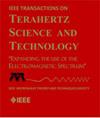降低太赫兹NbN热电子辐射热计混频器的噪声温度
IF 3.9
2区 工程技术
Q2 ENGINEERING, ELECTRICAL & ELECTRONIC
IEEE Transactions on Terahertz Science and Technology
Pub Date : 2024-10-07
DOI:10.1109/TTHZ.2024.3475010
引用次数: 0
摘要
在本文中,我们测量了NbN热电子辐射热计(HEB)混频器在1.6、2.5和5.3太赫兹三个本振频率下的双边带(DSB)接收器噪声温度($T_{\text{rec}}^{\text{DSB}})$。HEB的接触面为200nm厚的Au层。在1.6、2.5和5.3太赫兹下,使用总光损耗分别为2.60±0.04、2.63±0.16和4.70±0.24 dB的空气装置,测量到的$T_{\text{rec}}^{\text{DSB}}$值分别为530±11 K、640±18 K和2190±150 K。我们推导出低混频器噪声温度($T_{\text{mixer}}^{\text{DSB}})$在1.6太赫兹时为240±6 K,在2.5太赫兹时为290±13 K,与已发布的NbN HEB混频器相比,提高了30%以上。这种增强可以将外差仪器的积分时间减少大约2倍。在5.3太赫兹下,$T_{\text{mixer}}^{\text{DSB}}$为620±55 K,由于未优化的天线几何结构,改善有限。这些结果也有助于理解宽HEB (4 μm)在高频下的器件物理特性。该混合器是为研究恒星系统的轨道天文卫星和用于宇宙研究的单口径大望远镜(概念)任务而开发的。本文章由计算机程序翻译,如有差异,请以英文原文为准。
Reduced Noise Temperatures of a THz NbN Hot Electron Bolometer Mixer
In this article, we measure the double sideband (DSB) receiver noise temperature (
$T_{\text{rec}}^{\text{DSB}})$ $T_{\text{rec}}^{\text{DSB}}$ $T_{\text{mixer}}^{\text{DSB}})$ $T_{\text{mixer}}^{\text{DSB}}$
求助全文
通过发布文献求助,成功后即可免费获取论文全文。
去求助
来源期刊

IEEE Transactions on Terahertz Science and Technology
ENGINEERING, ELECTRICAL & ELECTRONIC-OPTICS
CiteScore
7.10
自引率
9.40%
发文量
102
期刊介绍:
IEEE Transactions on Terahertz Science and Technology focuses on original research on Terahertz theory, techniques, and applications as they relate to components, devices, circuits, and systems involving the generation, transmission, and detection of Terahertz waves.
 求助内容:
求助内容: 应助结果提醒方式:
应助结果提醒方式:


